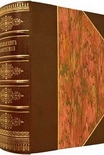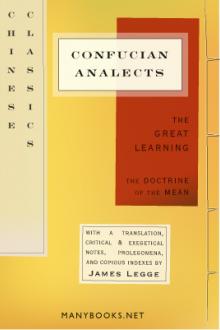Myths and Legends of China by E. Werner (free ebook reader for iphone TXT) 📗

- Author: E. Werner
Book online «Myths and Legends of China by E. Werner (free ebook reader for iphone TXT) 📗». Author E. Werner
The Project Gutenberg EBook of Myths and Legends of China, by E. T. C. Werner
This eBook is for the use of anyone anywhere at no cost and with
almost no restrictions whatsoever. You may copy it, give it away or
re-use it under the terms of the Project Gutenberg License included
with this eBook or online at www.gutenberg.net
Title: Myths and Legends of China
Author: E. T. C. Werner
Release Date: March 4, 2005 [EBook #15250]
Language: English
*** START OF THIS PROJECT GUTENBERG EBOOK MYTHS AND LEGENDS OF CHINA ***
Produced by Juliet Sutherland, Jeroen Hellingman and the PG Online
Distributed Proofreading Team.
Confucius: Teacher and Philosopher
Myths & Legends of China
By
E.T.C. Werner
H.B.M. Consul Foochow (Retired) Barrister-at-law Middle Temple Late Member of The Chinese Government Historiographical Bureau Peking Author of “Descriptive Sociology: Chinese” “China of the Chinese” Etc.
With Thirty-two Illustrations In Colours By Chinese Artists
George G. Harrap & Co. Ltd.
London Bombay Sydney
In Memoriam
Gladys Nina Chalmers Werner Page 7
Preface
The chief literary sources of Chinese myths are the Li tai shên hsien t’ung chien, in thirty-two volumes, the Shên hsien lieh chuan, in eight volumes, the Fêng shên yen i, in eight volumes, and the Sou shên chi, in ten volumes. In writing the following pages I have translated or paraphrased largely from these works. I have also consulted and at times quoted from the excellent volumes on Chinese Superstitions by Père Henri Doré, comprised in the valuable series Variétés Sinologiques, published by the Catholic Mission Press at Shanghai. The native works contained in the Ssŭ K’u Ch’üan Shu, one of the few public libraries in Peking, have proved useful for purposes of reference. My heartiest thanks are due to my good friend Mr Mu Hsüeh-hsün, a scholar of wide learning and generous disposition, for having kindly allowed me to use his very large and useful library of Chinese books. The late Dr G.E. Morrison also, until he sold it to a Japanese baron, was good enough to let me consult his extensive collection of foreign works relating to China whenever I wished, but owing to the fact that so very little work has been done in Chinese mythology by Western writers I found it better in dealing with this subject to go direct to the original Chinese texts. I am indebted to Professor H.A. Giles, and to his publishers, Messrs Kelly and Walsh, Shanghai, for permission to reprint from Strange Stories from a Chinese Studio the fox legends given in Chapter XV.
This is, so far as I know, the only monograph on Chinese mythology in any non-Chinese language. Nor do the native works include any scientific analysis or philosophical treatment of their myths. Page 8
My aim, after summarizing the sociology of the Chinese as a prerequisite to the understanding of their ideas and sentiments, and dealing as fully as possible, consistently with limitations of space (limitations which have necessitated the presentation of a very large and intricate topic in a highly compressed form), with the philosophy of the subject, has been to set forth in English dress those myths which may be regarded as the accredited representatives of Chinese mythology—those which live in the minds of the people and are referred to most frequently in their literature, not those which are merely diverting without being typical or instructive—in short, a true, not a distorted image.
Edward Theodore Chalmers Werner
Peking
February 1922 Page 9
Contents
Chapter
Page
I.
The Sociology of the Chinese
13
II.
On Chinese Mythology
60
III.
Cosmogony—P’an Ku and the Creation Myth
76
IV.
The Gods of China
93
V.
Myths of the Stars
176
VI.
Myths of Thunder, Lightning, Wind, and Rain
198
VII.
Myths of the Waters
208
VIII.
Myths of Fire
236
IX.
Myths of Epidemics, Medicine, Exorcism, Etc.
240
X.
The Goddess of Mercy
251
XI.
The Eight Immortals
288
XII.
The Guardian of the Gate of Heaven
305
XIII.
A Battle of the Gods
320
XIV.
How the Monkey Became a God
325
XV.
Fox Legends
370
XVI.
Miscellaneous Legends
386
Glossary and Index
425
Page 11
Illustrations
Page
Confucius: Teacher and Philosopher
Frontispiece
The Spirit that Clears the Way
44
Lao Tzŭ
72
Nü Kua Shih
82
Mencius
90
Wên Ch’ang, K’uei Hsing, and Chu I
110
The Buddhist Triad
120
The Taoist Triad
124
Hsi Wang Mu
136
Chang Tao-ling
138
Tou Mu, Goddess of the North Star
144
Chiang Tzŭ-ya At K’un-lun
156
Chiang Tzŭ-ya Defeats Wên Chung
160
The Kitchen-god
166
The Gods of Happiness, Office, and Longevity
170
The Money-tree
172
The Door-gods, Civil and Military
174
Hêng Ò Flies to the Moon
184
Wên Chung, Minister of Thunder
198
Dragon-gods
208
Spirit of the Well
216
The Magic Umbrellas
242
P’an Kuan
248
Miao Shan Reaches the Nunnery
262
The Tiger Carries Off Miao Shan
266
The Eight Immortals Crossing the Sea
302
The Birth of the Monkey
326
The Demons of Blackwater River Carry Away the Master
352
Buddhists as Slaves in Slow-carts Country
354
Sun Steals Clothing for His Master
364
The Return to China
368
Chia Tzŭ-lung Finds the Stone
382
Page 12
Mais cet Orient, cette Asie, quelles en sont, enfin, les frontières réelles?... Ces frontières sont d’une netteté qui ne permet aucune erreur. L’Asie est là où cesse la vulgarité, où naît la dignité, et où commence l’élégance intellectuelle. Et l’Orient est là où sont les sources débordantes de poésie.
Mardrus,
La Reine de Saba
Page 13
Chapter I
The Sociology of the Chinese
Racial Origin
In spite of much research and conjecture, the origin of the Chinese people remains undetermined. We do not know who they were nor whence they came. Such evidence as there is points to their immigration from elsewhere; the Chinese themselves have a tradition of a Western origin. The first picture we have of their actual history shows us, not a people behaving as if long settled in a land which was their home and that of their forefathers, but an alien race fighting with wild beasts, clearing dense forests, and driving back the aboriginal inhabitants.
Setting aside several theories (including the one that the Chinese are autochthonous and their civilization indigenous) now regarded by the best authorities as untenable, the researches of sinologists seem to indicate an origin





Comments (0)